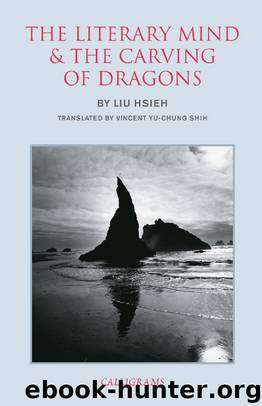The Literary Mind and the Carving of Dragons by Liu Hsieh

Author:Liu Hsieh [Hsieh, Liu]
Language: eng
Format: epub
ISBN: 978-962-996-931-8
Publisher: New York Review Books
Published: 2015-01-12T16:00:00+00:00
XIX. Edict and Script
(Chao Ts’e)
Translator’s note: From the text of this chapter, it seems obvious that no one of the terms used to stand for different types of writing has a specific sense in which it is used consistently in different contexts; and it is also obvious that our author made no attempt to clarify this confusion. As a matter of fact, this tendency to treat a term, which has many senses, as if it had only one sense, and to raise it to the status of a genre, while using it as inconsistently as it originally was used in different settings, is one of the major faults of Liu Hsieh, against which we have a legitimate complaint. Mark how the terms chao and ts’e are treated in this chapter. At first they are treated as if they were technical terms, serving to designate specific types of writing. But as we go along, we find to our grief that in addition to using chao specifically as a royal pronouncement, the author also uses it as a general term for all royal edicts; and the term ts’e, in addition to being used as a script of enfeoffment, is also used to mean writings in general. The same is true with the terms chih, ch’ih, kao, ming, etc. This seems to have originated from a deliberate policy of ignoring the semantic distinction between different senses of a term, and of effecting by means of ambiguity a loose and easy flow in literary associations of ideas. This explains in part the unscientific manner in which the genres are classified. They are neither mutually exclusive nor independently comprehensive. We find, for example, the genre of poetry discussed in Chapters V, VI, VII, and VIII. The genre lun is discussed specifically in Chapter XVIII; but it is also touched upon in Chapters III, IV, V, XVII, and many others. In Chapter XVII the lun is defined as a discourse devoted to the study of a specific subject; and works by Lu Chia, Chia I, Yang Hsiung, Liu Hsiang, Wang Fu, Ts’ui Shih, Chung-ch’ang T’ung, and Tu I are classified as philosophical writings, in spite of their having been named as lun, because some of them discourse on the Classics. But in Chapter XVIII, the lun includes not only philosophical works by the Taoists of the Wei and Chin, but also Mao’s commentary on the Book of Poetry, K’ung An-kuo’s commentary on the Book of History, Cheng Hsüan’s commentary on the Book of Rites, and Wang Pi’s commentary on the Book of Changes—a direct contradiction by Liu Hsieh of his own statement in the previous chapter. Here then, we find the major task of a student of Chinese literary criticism: to try to penetrate beyond the veil of literary terminology and feel his way through the labyrinth of the minds of Chinese authors, which are very inadequately expressed in words. Thus we may also find out why it is not possible for the ancients to do
Download
This site does not store any files on its server. We only index and link to content provided by other sites. Please contact the content providers to delete copyright contents if any and email us, we'll remove relevant links or contents immediately.
| Ancient & Classical | Arthurian Romance |
| Beat Generation | Feminist |
| Gothic & Romantic | LGBT |
| Medieval | Modern |
| Modernism | Postmodernism |
| Renaissance | Shakespeare |
| Surrealism | Victorian |
4 3 2 1: A Novel by Paul Auster(11310)
The handmaid's tale by Margaret Atwood(7046)
Giovanni's Room by James Baldwin(6200)
Big Magic: Creative Living Beyond Fear by Elizabeth Gilbert(4950)
Asking the Right Questions: A Guide to Critical Thinking by M. Neil Browne & Stuart M. Keeley(4856)
On Writing A Memoir of the Craft by Stephen King(4391)
Ego Is the Enemy by Ryan Holiday(4355)
Ken Follett - World without end by Ken Follett(4143)
The Body: A Guide for Occupants by Bill Bryson(4102)
Bluets by Maggie Nelson(3927)
Adulting by Kelly Williams Brown(3833)
Guilty Pleasures by Laurell K Hamilton(3775)
Eat That Frog! by Brian Tracy(3713)
White Noise - A Novel by Don DeLillo(3557)
The Poetry of Pablo Neruda by Pablo Neruda(3504)
Alive: The Story of the Andes Survivors by Piers Paul Read(3436)
The Book of Joy by Dalai Lama(3376)
Fingerprints of the Gods by Graham Hancock(3372)
The Bookshop by Penelope Fitzgerald(3371)
